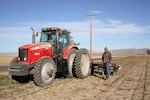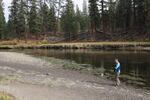On a crisp fall day, a team of volunteers waded upstream in the Deschutes River in pursuit of fish.
Instead of fishing rods, they carried an electroshock device, nets and buckets.
“Sweet, first fish,” said technician Josh Richards, after sending a shock into the rippling water. A trout the size of his pinky finger floated to the surface, belly up.
Volunteer Shaun Pigott netted the shimmery fish and gingerly dropped it into a water-filled bucket.
That fish, along with hundreds of others, were moved bucket brigade style from a side channel into the main stem Deschutes River.
It might sound counter-intuitive, but shocking and moving these fish is actually doing them good.
Every fall, side channel habitat turns into a tiny trickle of water. That’s when managers start holding the river back behind Wickiup Dam. Pigott, also the president of the local Trout Unlimited chapter, said that the holding back of water strands fish in shallow water that freezes over winter.
“If the fish aren’t rescued, in all likelihood they’d die," Pigott said. “These fish are effectively stranded when the river goes down."
The solution for the stranded wildlife on the Upper Deschutes sounds simple: The upper river needs more water and more stable flows year-round.
But the route there involves dozens of stakeholders, the government and eventually bartering a massive water trade between the weakest and most powerful water interests in the region — all at a cost of hundreds of millions of dollars.

Farmer Phil Fine relies on water out of Wickiup Reservoir to irrigate his fields every summer.
Amanda Peacher / OPB
Farmers Count On Reserves
Fifty miles south of the fish rescue, farmer Phil Fine maneuvered his tall red tractor down one of his vast fields planted with carrots for next year, row after row of tiny, inch-long leaves poking out of the soil.
Those carrots, of course, need the same water the fish need.
“That’s the only guaranteed water we have,” said Fine.
Fine is part of the North Unit Irrigation District, one of several water districts that take water out of a different part of the Deschutes River. North Unit’s water rights are tied to Wickiup Reservoir on the Upper Deschutes. It’s the management of the Wickiup that dictates how much water is in the Upper Deschutes River.
“The river shouldn’t be treated like an irrigation ditch,” said Jim McCarthy, communications manager for the environmental group WaterWatch. “It should be managed like a river. It shouldn’t be managed for a single interest."
Unlike some rivers, the Deschutes historically had pretty much the same amount of water in it year-round.
“The Deschutes River was once called the peculiar river because it has very stable flows,” said Gail Snyder, co-founder of a conservation group Coalition for the Deschutes.
But now it is a heavily managed basin built out with dams and canals. That means the upper water supply dries up every fall, when dam managers start holding back water to use during irrigation season. In the past, the river became a series of puddles and mud flats at some points.
“The river was truly a sad little trickle,” Snyder said.
In the summer, the problem is the opposite. When dam managers open up the Wickiup Reservoir to let water out for farmers, there’s too much flow in the Upper Deschutes.

Winter flows in the Upper Deschutes are far lower than they were historically. That's because dam managers upstream start holding water back for summer irrigation.
Ryan Haas / OPB
Frog Lawsuit Forces Conservation
Big variations in water flow can be harmful for wildlife — especially for the Oregon spotted frog, which was put on the federal Endangered Species List in 2014.
When the river loses water, wetland frog habitat along the Upper Deschutes dries up. When the river has too much water, frog eggs flush downstream and die.
Biologists see the frog as a bellwether species that signals how unhealthy the Upper Deschutes river is more broadly.
“It’s not a great picture for the frog right now,” said Bridget Moran, who manages the U.S. Fish and Wildlife Service Bend office. “The listing of the frog brought to the surface a need for the broader restoration of the river.”
Related: Agreement Reached To Help Oregon's Spotted Frog
After the spotted frog was put on the Endangered Species List, WaterWatch and the Center for Biological Diversity ratcheted up the pressure with a lawsuit that forces more water distribution for the Upper Deschutes.
That's meant those who need water from the river for irrigation have no choice — come to the table and figure out how to work together or possibly say goodbye to the water supply.
“Everybody really wants to make sure the other needs are met,” said Moran. “Nobody wants to chase agriculture out of here. Nobody wants to see the fishery impacted.”
There actually is enough water in the entirety of the Deschutes Basin to meet all these needs — from frogs to farming. But the allocation of that water and and how to bring the upper river back to a healthy state is a conversation that’s been going on for years.
Stakeholders like WaterWatch, the Deschutes River Conservancy, the USFWS and irrigation districts have been meeting for nearly a decade trying to come up with a workable compromise.
But how to release a stable supply of water without hurting farmers has been a key sticking point.
Eight years into talks, WaterWatch decided the process was dragging out without any solid commitments from irrigation districts, and that’s when the group decided to sue.
“It is stunning to think that it has taken this long for a river this beautiful to be taken care of in the way it needs to be taken care of,” McCarthy said, pointing out that the Upper Deschutes is upstream of Bend, one of the most popular and important water recreation sites in Oregon.
Irrigators agreed to increase water releases to 100 cubic feet per second in a temporary settlement last year. That's a notable increase from the 25 cubic feet per second in years past that left the river a mere trickle.
Still, it may not be enough.
Farmers Must Solve The Problem
A federal biological opinion for the spotted frog says the Upper Deschutes needs about 600 cubic feet per second — six times the amount of water currently being released in winter.
If water managers were to suddenly start releasing that amount, North Unit irrigators wouldn’t be able to plant crops next spring.
“That puts out us out of business,” said Fine.
There’s not much opportunity for conservation from North Unit. Fine said his district has barely enough water for irrigators, and it’s already maxed out options for saving water both on individual farms and within canals and ditches.
“We’re a highly efficient district, one of the best in the country, and the reason is because we have to be,” said Fine.
While North Unit irrigators don’t have water to spare, another water district does.
The Central Oregon Irrigation District is the most senior water rights holder in the region — it’s a 100-year-old organization with 450 miles of canals and ditches that stretch from Bend to Smith Rock. In 1907, builders used the most convenient local material around — porous lava rock found all over central Oregon — to construct canals.
Those old canals leak about 45 percent of the water they transport.
Because of COID’s senior water rights status, it hasn’t had reason to upgrade the system or force water conservation measures. A farmer in COID pays half as much for the same amount of water as a North Unit farmer. And COID patrons are also allowed to use twice as much water per acre as North Unit.
And unlike North Unit, there’s no imminent threat of losing water in an endangered species battle. Most of their water comes from areas of the river that are outside of spotted frog habitat.
The pressure for COID to be part of the solution comes from a conservation community tired of seeing dead fish scattered on mud flats when the Upper Deschutes is de-watered in winter.
“It is a reality. Central Oregon Irrigation District could walk away at any time,” said District Manager Craig Horrell. “(But) we’re not going to do that. We are here doing this out of social responsibility more than anything.”
Horrell said the solution to canal seepage is to to build pipes in place of those canals.
Related: Deschutes County Approves Landfill Sale To OSU-Cascades For $1
That’s not a popular idea with neighbors who like living next to a waterway. The idea has drawn ire from neighborhood groups who’ve lobbied to get the canals listed on the national registry of historic places — a designation that can make it difficult, if not impossible, to replace a canal with a pipe.
But piping the canals provides huge opportunities for the district to conserve water. The idea is that Central Oregon Irrigation District could then “give” some of that water they conserve to North Unit. That way, North Unit irrigators could put more water upstream back into the river for fish and frogs.
It’s a modern and expensive horse trade of water that could take decades.
Piping COID’s two main canals would cost between $500 and $600 million, according to the district's figures. That could mean higher costs for COID water users, so Horrell will have to convince his water users that piping and water conservation are the right path for the long term.
Though COID could resist and fight these changes, it looks like the big compromise could be on its way.
Earlier this year, Sen. Jeff Merkley, D-Oregon, helped secure $150 million of congressional funding for several Deschutes basin piping projects. Central Oregon Irrigation District plans to start constructing its first canal next year.
Fine, the Madras carrot farmer, believes that Horrell and other COID leaders want to come to a solution to return water to the Upper Deschutes. But he’s worried about future lawsuits, or that this massive collaboration could fall apart at any moment.
He and other North Unit farmers are, in some sense, at the mercy of their senior water rights holder neighbors.
“I would love to fix the river today. But I can’t do that and continue to farm and support my family,” said Fine.
Ultimately, he said, they're working with an antiquated water system that needs change.
“Our government designed the system. We inherited it," Fine said. "It’s just going to take a lot of time and money to fix."
